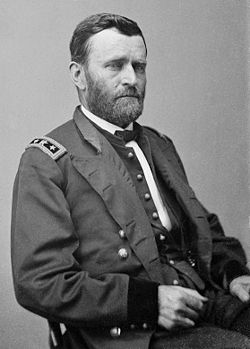 |
| Coles County |
With the judge in town tensions were high between the Copperheads and Union soldiers home on leave. A Democratic rally was scheduled for the day, with Democrats John Eden, Congressman of the district, scheduled to speak, and Sheriff John O'Hair in attendance. Both soldiers and civilians were drinking heavily, and both had brought guns with them, knowing that trouble was possible.
 |
| The courthouse, around which fighting took place |
There were about sixteen Union soldiers in the square when the shooting broke out. There were many more Copperheads on hand, and they ran to their wagons to retrieve their weapons. The soldiers got the worst of the quick fight. When the smoke settled six soldiers were killed and four wounded, including the Colonel of the 54th Illinois. One Republican civilian was killed and three wounded. On the Copperhead side there were only two killed and six wounded, including the sheriff, who was nicked by a ball inside the courthouse.
As the fighting stopped, Colonel Mitchell gathered what men he could find and telegraphed for reinforcements. The Copperheads, led by Sheriff O'Hair, quickly left the town. They decided not to return and try to drive out the soldiers, or the mob, as the sheriff called them. Instead the group scattered.
For several days rumors ran wild, some saying that the sheriff was going to attack Charleston with 1,500 men. However, this was the end of the fighting in Charleston, IL. Fifty known Copperheads were rounded up by the military, and after some questioning all but fifteen of them were released. These were denied the right of habeas corpus and sent to prison at Fort Delaware. Lincoln ordered their release seven months later. Two were tried for murder and acquitted, and twelve others were indicted but never arrested or tried.
Unsurprisingly, the riot was interpreted by the press in accordance with their politics. The Republican Plain Dealer of Charleston said:
What the end. of this state of things will be, we can. not tell; but if the government does not now take the matter in hand, we fear that the terribly exasperated soldiery and citizens will. Union men have long been threatened and Union soldiers have been so bitterly cursed, and now brutally butchered, by those from whom better things had been. expected, that forbearance will cease—has ceased—to be a virtue. Loyal men here, and the soldiers at the front, are endeavoring to uphold the laws of the land; but they cannot, and will not, stand unconcernedly by. and see their fellows assassinated for so doing.On the other side, the New York World wrote, “The troubles in the West are clearly due to an. unhealthy public sentiment among the Republicans, countenancing drunken soldiers in insulting peaceable citizens.” You can read this article for more of the history of this story.







